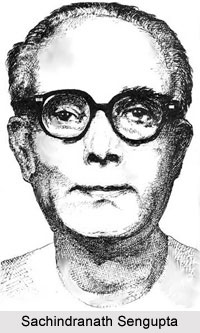 Sachindranath Sengupta was an important dramatist in the contemporary Bengali theatre. Born in 1893, he had a chequered schooling, marked by many unfinished programmes. Yet he was known face in the Bengali theatre circuit. He contributed tremendously to the success of Bengali theatre.
Sachindranath Sengupta was an important dramatist in the contemporary Bengali theatre. Born in 1893, he had a chequered schooling, marked by many unfinished programmes. Yet he was known face in the Bengali theatre circuit. He contributed tremendously to the success of Bengali theatre.
Early Life of Sachindranath Sengupta
Although he decided on a career in traditional medicine, the whirlwind of the freedom movement landed him into journalism first. He first wrote in Chittaranjan Das`s journal, Narayan. Soon he began to edit various periodicals of the time like Bijoli, Atmashakti, Nabashakti, and the dailies Krishak and Bharat. His colleagues vouch for his spirit and uprightness as an editor, for he did not shrink from confronting the authorities on matters of principle. Such an encounter with the Bose brothers, Sarat and Subhas, made him leave journalism and turn to another love, theatre, in 1930.
Career in Theatre for Sachindranath Sengupta
Sachindranath Sengupta`s first play -"Raktakamal", was drastically reduced by half the normal five-hour duration of a public theatre production. His second, Gairik pataka i.e. "Saffron Flag" in 1930 was based on Shivaji`s life. It contained patriotic statements with ill-concealed contemporary reference, though the narrative was patently historical. This nationalistic agenda, with a liberal non-communal vision was again repeated in Sirajuddaula in 1938. This was one of the most successful historical Bengali plays. Others in this genre, namely Dhatri Panna i.e. "Tanna the Nurse` in 1943 and Rashtrabiplab or "The Revolution" in 1944 had only a slender base of history. In all these works Sengupta used florid language charged with emotion as well.
Sachindranath Sengupta explored the theme of women`s rights and independent identity in social and domestic melodramas namely `Stormy Night`, Janani or `Mother`, Swami-Stri or `Husband and Wife`, etc. The last one was based on Bjornstjerne Bjornson`s `The Newly weds`. The hit Tatinir Bichar i.e. `Judgment of Tatini` in 1938 and Kanta o kamal i.e. `Thorn and Lotus` in 1942 were adapted from Maupassant`s Useless Beauty and also by giving women prominence in his historical drama. Some of his plays reflected contemporary Indian reality and politics. The names can be mentioned as Daser Dabi i.e. `Workers` Demand` in 1934, Naradebata or `Man-God` in 1935 and Sangram O Shanti i.e. `War and Peace` in 1939. The state of society at the time of India`s independence seemed to have disillusioned him as he wrote about corruption and distress in Swadhinatar Sadbana or `Penance for Independence` in 1947, Kalo Taka i.e. `Black Money` in 1947, and Ei Swadhinata i.e. `This Independence` in 1949.
Sengupta also created highly popular dramatizations of fiction by Bankimchandra Chatterjee, Rabindranath Tagore, Saratchandra Chatterjee, and Bimal Mitra. He wrote a critical history of Bengali theatre, Banglar Natak o Natyashala i.e. `Bengali Drama and Theatre` in 1957, and travelogues of trips to various lands. He was the senior-most Bengali playwright to associate with the left cultural movement spearheaded by the Indian People`s Theatre Association and became its all-Indian President. This post he held till his death.
Sachindranath Sengupta died in the year 1961.




















